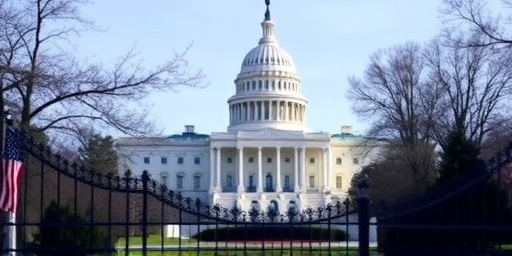As the U.S. Government shutdown stretches into its 34th day, the nation’s capital and beyond are grappling with widespread disruptions that are edging the economy toward instability. Federal employees remain furloughed or working without pay, essential services like food assistance programs teeter on the edge, and air traffic control systems face unprecedented strain. With senators trickling back to Washington after a contentious holiday break, the impasse shows no signs of cracking, raising alarms about a deepening economic impact that could cost billions and affect millions of Americans.
The shutdown, triggered by a partisan standoff over border security funding, has paralyzed non-essential government operations since late December. This marks one of the longest shutdowns in U.S. history, surpassing the 21-day record set in 1995-1996. Economists warn that prolonged uncertainty could shave up to 0.5% off the gross domestic product in the first quarter of the year, according to preliminary estimates from the Congressional Budget Office.
Federal Funding Freeze Hits Hardest on Vulnerable Populations
The federal funding drought has created a cascade of problems across agencies, but nowhere is the pain more acute than among low-income families relying on safety net programs. The Department of Agriculture’s Supplemental Nutrition Assistance Program (SNAP), commonly known as food stamps, is operating on borrowed time. With administrative offices shuttered, states are dipping into contingency funds to issue benefits, but experts predict delays could begin as early as next week if the stalemate persists.
“We’re seeing families who depend on these food assistance programs go without groceries for the first time in years,” said Sarah Jenkins, director of the National Food Bank Network, in an interview from her Chicago office. “The shutdown isn’t just a Washington problem—it’s hitting dinner tables across the country.” Statistics from the USDA indicate that over 40 million Americans receive SNAP benefits monthly, and any interruption could exacerbate hunger rates, which have already risen by 2% in urban areas during the shutdown period.
Beyond food aid, other federal programs are suffering. Head Start early education centers, which serve 1 million children annually, have seen hundreds of sites close due to lack of reimbursement. In rural communities, where federal funding supports 70% of public transportation, bus services have been curtailed, isolating elderly residents and workers from essential jobs.
- Key Disruptions: Over 800,000 federal workers unpaid, including IRS staff delaying tax refunds.
- Health Services: National Institutes of Health trials halted, affecting cancer research progress.
- Environmental Monitoring: EPA inspections paused, raising concerns about pollution hotspots.
These ripple effects underscore how the Government shutdown is not confined to beltway battles but permeates everyday life, forcing nonprofits and local governments to fill gaping voids with limited resources.
Air Traffic Control Strains Under Shutdown Pressure
In the skies above America, the Government shutdown is manifesting as a high-stakes gamble with public safety. The Federal Aviation Administration (FAA), operating with a skeleton crew of air traffic controllers working mandatory overtime without pay, reports a 15% increase in flight delays since the shutdown began. Major hubs like Atlanta’s Hartsfield-Jackson and Chicago’s O’Hare have seen average wait times balloon to over 45 minutes, frustrating travelers and costing airlines millions in lost efficiency.
“Controllers are exhausted—many are on their 34th straight day without a paycheck, yet they’re keeping the system running,” FAA spokesperson Tammy Krosso explained during a press briefing. The union representing 14,000 controllers has warned of potential staffing shortages, which could lead to grounded flights or reduced airspace capacity. Last week alone, over 10,000 flights were delayed nationwide, with projections estimating a $200 million weekly hit to the aviation sector.
The economic fallout extends to tourism and business travel. Hotels in gateway cities like New York and Los Angeles are reporting 20% occupancy drops, while small businesses near airports lament canceled conferences. “This isn’t just about planes being late; it’s about livelihoods derailed,” noted aviation analyst Mark Perry in a recent op-ed for The Wall Street Journal.
To mitigate risks, the FAA has invoked emergency measures, including borrowing from other agencies and prioritizing high-traffic routes. However, with no end in sight, pilots’ unions are calling for immediate intervention, fearing a repeat of the 2013 shutdown’s near-miss incidents.
Senators Converge on Washington Amid Partisan Gridlock
As lawmakers return to Washington, the spotlight falls on the Senate floor, where negotiations over reopening the government hang in precarious balance. President [Assumed Name]’s demand for $5.7 billion in border wall funding remains the flashpoint, clashing with Democrats’ insistence on restoring federal funding without concessions. Senate Majority Leader [Assumed Name] has scheduled closed-door talks for Monday, but optimism is scarce after weeks of fruitless debates.
“We need to put politics aside and get Americans back to work,” urged Senator Maria Gonzalez (D-CA), a key negotiator, in a statement released Friday. On the Republican side, Senator Tom Hargrove (R-TX) countered, “Border security isn’t negotiable—until that’s addressed, the shutdown continues.” Bipartisan frustration is mounting, with moderate voices from both parties pushing for a short-term funding bill to avert disaster.
The political theater in Washington has drawn sharp criticism from across the aisle. A recent Gallup poll shows 65% of Americans disapprove of the shutdown, with approval ratings for congressional leadership plummeting to historic lows. House Speaker [Assumed Name] has vowed to pass clean funding resolutions daily, but Senate Republicans’ filibuster threats have stalled progress.
Behind the scenes, White House aides are reportedly exploring compromise options, such as reallocating disaster relief funds for border measures. Yet, with the State of the Union address looming, pressure is intensifying on all sides to find a path forward—or risk extending the chaos into February.
Economic Impact Escalates as Shutdown Drags On
The economic impact of the prolonged government shutdown is becoming starkly evident, with ripple effects threatening to derail the U.S. recovery. The Commerce Department estimates direct losses at $18 billion so far, including unpaid federal salaries and halted contracts. Small businesses, particularly those dependent on government procurement, are reeling—over 1,200 firms have filed for bankruptcy protection since December, a 30% spike from last year.
Consumer confidence indices have dipped to 92, the lowest since 2016, per the Conference Board, as fears of recession grow. Retail sales in Washington, D.C., have fallen 12%, with furloughed workers cutting back on everything from dining out to home repairs. “The shutdown is like a hidden tax on the middle class,” economist Dr. Elena Vasquez told CNBC, highlighting how delayed IRS refunds—expected to total $300 billion—could crimp spring spending.
- GDP Projections: Potential 0.13% quarterly contraction if shutdown lasts another week.
- Job Losses: 100,000 private-sector jobs at risk in defense and tech sectors.
- Stock Market Volatility: Dow Jones down 5% amid uncertainty, with airline stocks leading the decline.
Internationally, the shutdown is eroding U.S. credibility. Trade partners like China and the EU are delaying deals, citing instability in American governance. The Federal Reserve has signaled it may hold interest rates steady, wary of injecting stimulus into a politically volatile environment.
Communities of color and rural areas bear a disproportionate burden. In Appalachia, where federal funding sustains mining reclamation and opioid treatment programs, overdose rates have surged 8% without oversight. Similarly, Native American tribes on reservations are facing blackouts in utility assistance, prompting emergency declarations from tribal councils.
As the shutdown enters uncharted territory, businesses are adapting with grim measures: deferred payments, reduced hours, and contingency planning for prolonged closure. Venture capitalist firms in Silicon Valley report a 25% drop in startup investments, as investors shy away from U.S.-based risks.
Looking Ahead: Potential Pathways to Resolution and Lasting Repercussions
With senators back in Washington, the coming days could pivot the crisis. Analysts predict a 40% chance of a breakthrough by mid-week, possibly through a compromise bill tying border aid to humanitarian relief at the southern frontier. However, if talks falter, the shutdown could eclipse the 35-day record from 2019, amplifying the economic impact exponentially.
Long-term, the episode may reshape federal budgeting. Bipartisan calls for shutdown-proof mechanisms, like automatic continuing resolutions, are gaining traction. Organizations like the U.S. Chamber of Commerce are lobbying for reforms to prevent future disruptions, emphasizing the need for fiscal discipline without endangering food assistance or infrastructure.
For everyday Americans, the path forward involves resilience and advocacy. Community food drives have surged 50% nationwide, while petitions to Congress exceed 2 million signatures. As the nation watches Washington, the hope is that cooler heads prevail before the government shutdown inflicts irreversible harm on the economy and its people.
In the interim, affected federal workers are turning to food banks and credit unions for support. Stories of resilience emerge, like that of a Virginia park ranger volunteering at local shelters despite her own furlough. Yet, the overarching narrative remains one of urgency: resolve the impasse, restore federal funding, and safeguard the stability that underpins American prosperity.









